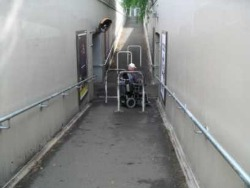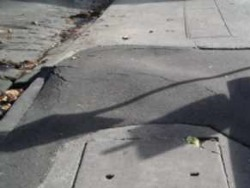Case study - infrastructure management, Yarra CC
 Access problems at Clifton Hill Station identified in Encouraging and Increasing Walking Strategy
Access problems at Clifton Hill Station identified in Encouraging and Increasing Walking Strategy
The City of Yarra recognises that walking is not only a means of transport, it is also important as a means of improving individual health and is a major form of recreation for people of all ages, regardless of their income levels. The council’s efforts to encourage and increase walking involve improving the amenity of public space and making it attractive to walkers and promoting the benefits of walking to Yarra residents.
Council's pedestrian projects are guided by both the Strategic Transport Statement (which places pedestrians at the top of the hierarchy used to make decisions about infrastructure projects) and the Encouraging and Increasing Walking Strategy (see Yarra's Transport Policy).
Each year the Transport Unit is allocated a ‘pedestrian provisions’ budget to undertake works to make walking easier in the City. These works are things like; pram ramps, at-grade crossings, increases in footpath widths, kerb extensions and pedestrian crossings. Within this budget there is a specific allocation towards safety around schools.
Inspection program
 Trip hazard noted in Encouraging and Increasing Walking Strategy
Trip hazard noted in Encouraging and Increasing Walking Strategy
The Council divides the municipality into 21 Local Areas and undertakes about two Local Area Traffic Management Studies (LATMS) a year. This involves all kinds of traffic management and where possible includes projects that increase walkability. One of the key things the LATM process has achieved has been a reduction in speed for areas where LATMS have been completed. Council has successfully applied to VicRoads to make these areas 40km zones.
Council’s Road Management Plan outlines the way footpaths are maintained and renewed. Footpaths in the municipality are scheduled for maintenance or replacement through regular inspection. Council undertakes the following inspections:
- Six Week Drive Through Inspection – undertaken every six weeks and checks both footpaths and roads.
- Road Reserve Inspection Program – a rolling program which inspects each of the LATM areas every two years on foot and looks at every footpath to a very high level of detail.
- Park Paths and Shared Paths Inspection – undertaken annually on foot or by bicycle for all park and shared paths and twice annually for paths nominated as high use or signfiicant.
- In addition to the above, Council has a Reactive Maintenance provision which allows Council to fix problems with footpaths and roads as the need arises outside of the scheduled maintenance.
See Council’s Road Management Plan for more information.